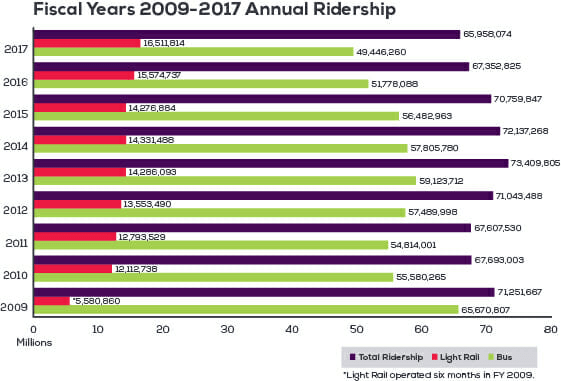Phoenix Transit Ridership Continues to Fall as Light Rail Investment Goes Up
Well, the numbers are in for the 2017 fiscal year (which ends June 30) and after another huge investment in light rail, Phoenix has lost more transit ridership. From the Valley Metro web site:
First, credit where it is due. After years of bizarre chartsmanship where bars on their graphs bore only a passing relationship to the numbers being graphed, Valley Metro seems to have adopted a new (or their first) graphing program.
As you can see, while light rail trips were up by about a million, bus trips were again down by over 2 million, for a net loss in transit ridership of over a million, the fourth year in a row this has been the case. I had expected rail ridership to rise, since in 2016 the rail system was expanded by 31% in length and 36% in cumulative investment. This extension resulting in a 15.6% increase in rail ridership between 2015 and 2017. Early on, I got in a debate with supporters of the line arguing that since they had cherry-picked the densest corridor in town to start, incremental extensions would actually reduce ridership per mile because they would be serving less promising routes. Supporters argued that I was ignoring network effects and that ridership would rise faster than line length. I guess we are sorting out that argument now.
In the ten years leading up to the opening of the light rail line, transit ridership grew by an average of 6.7% a year in Phoenix. In the 8 years since the rail line's opening, total transit ridership has fallen 1% per year. This is a well known effect (at least well known to all but rail die-hards) that Randal O'Toole, among others, has been pointing out for years. Since light rail is an order of magnitude more expensive to operate per passenger-mile, and since transit budgets are never infinite, growing light rail tends to strangle bus traffic, because bus routes and service have to be cut to feed money into the light rail money pit. Since every dollar spent on rail moves fewer passengers than a dollar spent on buses, transferring money from buses to trail reduces total ridership. It is worth noting that had the line not been built and bus transit had been allowed to grow as it had before the line, there might have been over 40 million more trips last year assuming pre-2009 growth rates.

And, unlike bus transport, you can't change routes on light rail, since there is actually nothing particularly light about it.
I suspect the credit should go to you and perhaps Mr. O'Toole for shaming them into reality.
The decrease in ridership would seem to me to be an indicator of increasing prosperity. One of the first things people do if they get a better income is buy a car. Urban planners are obsessed with rapid transit but people hate it. If you go shopping by transit you simply cannot buy groceries for the week because you can't carry it. Buying some lumber? sure, take it on the bus hahahah. If you go out with 2 kids and a stroller, transit is a nightmare.
The real tragedy is than many bus riders don't have a choice as they don't drive or cannot afford a car. LA got sued by people in South Los Angeles when bus schedules were cut to pay for the rail line that went west from downtown toward Santa Monica. The bus riders won and the city had to reinstate bus some bus lines. The real issue with public transportation however is how long it takes to get anywhere. Some of our employees use it and a 15-20 minute ride by car typically takes an hour or more. But when did governments ever have an appreciation for people's time.
I was just about to point that out. The ridership numbers decline is not all that large despite the fact it looks like it and if a single rider takes 1 bus a day for 350 days of the year to get to and from work/school/shopping/etc that is 700 "riders" (each boarding and unboarding constitutes a single rider by mass transit statistical accounting), multiply that by how many people have since stopped taking the bus due to their economic situation improving so they can drive, or has changed to carpooling with coworkers, or the bus line cutting service and a bunch of other possibilities, its small changes of who is and where they are riding and why that are being magnified by the loss of their multiple countings when using the public transportation network.
From a bus riders standpoint its actually inefficent to ride the bus on multiple routes because the transfers require extra time spent waiting so its an incentive for those who ride the bus to move to an area that only requires one bus instead of two or more, so as the economy improves there's also the change in living to where instead of having to take multiple buses, they can cut that down to one.
Ridership on the light rail itself is increasing due to the fact that the corridor the light rail follows is high value and developers have been seeking to take advantage of that, though I can't imagine that could ever grow to the scale of a high density developed city like Toronto where their streetcar and light rail networks is complimented by the very high density development of the city. It has had an effect on the Phoenix city development, but I don't think the light rail is all that beneficial or detrimental.